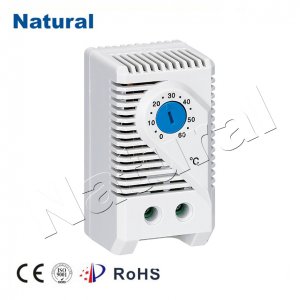Electric cabinet thermostats, often overshadowed by their more conspicuous counterparts, play a vital role in maintaining the optimal temperature within electrical cabinets and enclosures. These unassuming devices are indispensable in a wide range of industrial and commercial settings, ensuring the safe operation of electronic equipment. In this article, we will delve into the world of electric cabinet thermostats, exploring their essential functions and the impact they have on electrical systems.

1. Temperature Regulation: The Core Function Electric cabinet thermostats are primarily responsible for maintaining a stable temperature within electrical enclosures. The temperature inside these enclosures can fluctuate due to various factors, including external ambient temperature, heat generated by electrical components, and environmental conditions. To prevent overheating, electric cabinet thermostats are employed to monitor the temperature and initiate cooling or heating processes as necessary. 2. Thermostat Operation The operation of an electric cabinet thermostat is relatively straightforward. A sensor placed within the enclosure continuously monitors the internal temperature. When the temperature exceeds a preset threshold, the thermostat activates the appropriate cooling or heating system. This can involve fans, heaters, or heat exchangers, depending on the desired effect. Once the temperature returns to the desired range, the thermostat switches off the auxiliary system, conserving energy and maintaining efficiency. 3. Cooling Systems In environments where electronic equipment generates significant heat, cooling systems are essential. Electric cabinet thermostats work in tandem with fans or air conditioning units to dissipate excess heat. As the temperature rises, the thermostat signals the fans to increase their speed, facilitating air circulation and heat exchange. This process continues until the temperature stabilizes within the acceptable range. 4. Heating Systems In colder climates or during specific applications, maintaining a minimum temperature inside electrical cabinets is crucial to prevent condensation or freezing. Electric cabinet thermostats are equally adept at activating heating elements when temperatures drop too low. These heating systems, often consisting of heating pads or resistive elements, ensure that sensitive electronics remain operational even in frigid conditions. 5. Energy Efficiency and Cost Savings Electric cabinet thermostats are instrumental in reducing energy consumption and operating costs. By activating auxiliary cooling or heating systems only when necessary, they prevent continuous operation, saving electricity and reducing wear and tear on the equipment. This energy-efficient approach not only benefits the environment but also significantly cuts down on operational expenses over time. 6. Application Diversity The applications of electric cabinet thermostats are vast and varied. They are commonly found in industries such as manufacturing, telecommunications, and energy production, where electronic components are housed in enclosures. Beyond industrial settings, these thermostats are also utilized in commercial spaces, data centers, and outdoor installations to ensure the longevity and reliability of electrical systems. 7. Safety Considerations In addition to temperature regulation, electric cabinet thermostats contribute to the safety of electrical systems. By preventing overheating, they reduce the risk of electrical fires and equipment failures. In critical applications, the absence of an electric cabinet thermostat could lead to catastrophic consequences, making their presence indispensable. 8. Maintenance and Monitoring Regular maintenance and monitoring of electric cabinet thermostats are crucial to their effectiveness. Periodic checks ensure that these devices are functioning correctly, preventing potential issues and downtime. Modern electric cabinet thermostats often come equipped with remote monitoring capabilities, allowing for real-time temperature tracking and immediate response to any anomalies. In conclusion, electric cabinet thermostats may operate behind the scenes, but their significance in maintaining the reliability and safety of electrical systems cannot be overstated. These unassuming devices quietly regulate temperature, optimize energy usage, and safeguard sensitive electronic components across a broad spectrum of industries. Their contribution to the seamless functioning of countless applications is a testament to their ingenuity and importance in the world of electrical engineering.